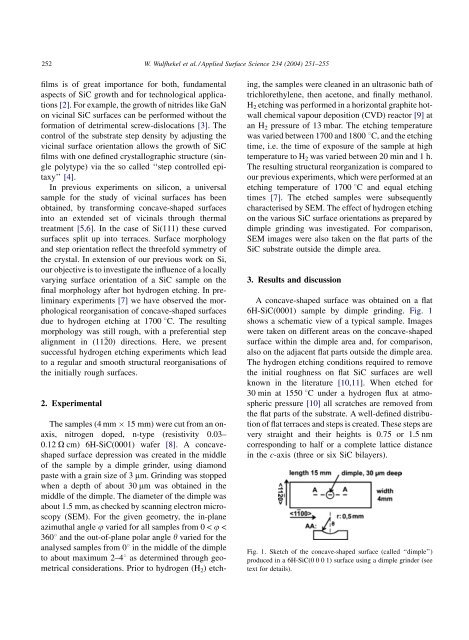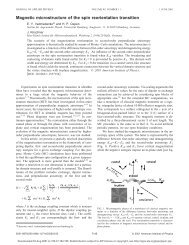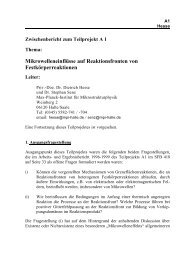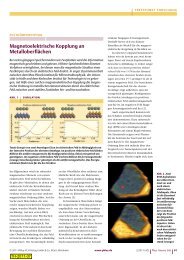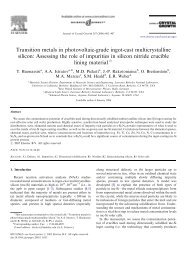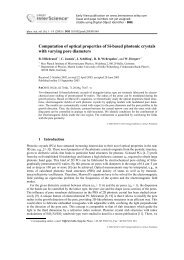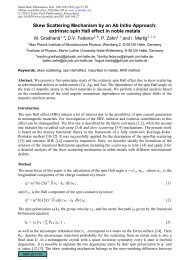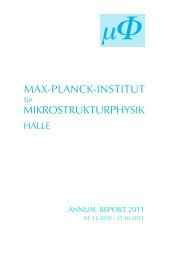Structural reorganisation of vicinal surfaces on 6H-SiC(0001 ...
Structural reorganisation of vicinal surfaces on 6H-SiC(0001 ...
Structural reorganisation of vicinal surfaces on 6H-SiC(0001 ...
You also want an ePaper? Increase the reach of your titles
YUMPU automatically turns print PDFs into web optimized ePapers that Google loves.
252 W. Wulfhekel et al. / Applied Surface Science 234 (2004) 251–255<br />
films is <str<strong>on</strong>g>of</str<strong>on</strong>g> great importance for both, fundamental<br />
aspects <str<strong>on</strong>g>of</str<strong>on</strong>g> <strong>SiC</strong> growth and for technological applicati<strong>on</strong>s<br />
[2]. For example, the growth <str<strong>on</strong>g>of</str<strong>on</strong>g> nitrides like GaN<br />
<strong>on</strong> <str<strong>on</strong>g>vicinal</str<strong>on</strong>g> <strong>SiC</strong> <str<strong>on</strong>g>surfaces</str<strong>on</strong>g> can be performed without the<br />
formati<strong>on</strong> <str<strong>on</strong>g>of</str<strong>on</strong>g> detrimental screw-dislocati<strong>on</strong>s [3]. The<br />
c<strong>on</strong>trol <str<strong>on</strong>g>of</str<strong>on</strong>g> the substrate step density by adjusting the<br />
<str<strong>on</strong>g>vicinal</str<strong>on</strong>g> surface orientati<strong>on</strong> allows the growth <str<strong>on</strong>g>of</str<strong>on</strong>g> <strong>SiC</strong><br />
films with <strong>on</strong>e defined crystallographic structure (single<br />
polytype) via the so called ‘‘step c<strong>on</strong>trolled epitaxy’’<br />
[4].<br />
In previous experiments <strong>on</strong> silic<strong>on</strong>, a universal<br />
sample for the study <str<strong>on</strong>g>of</str<strong>on</strong>g> <str<strong>on</strong>g>vicinal</str<strong>on</strong>g> <str<strong>on</strong>g>surfaces</str<strong>on</strong>g> has been<br />
obtained, by transforming c<strong>on</strong>cave-shaped <str<strong>on</strong>g>surfaces</str<strong>on</strong>g><br />
into an extended set <str<strong>on</strong>g>of</str<strong>on</strong>g> <str<strong>on</strong>g>vicinal</str<strong>on</strong>g>s through thermal<br />
treatment [5,6]. In the case <str<strong>on</strong>g>of</str<strong>on</strong>g> Si(111) these curved<br />
<str<strong>on</strong>g>surfaces</str<strong>on</strong>g> split up into terraces. Surface morphology<br />
and step orientati<strong>on</strong> reflect the threefold symmetry <str<strong>on</strong>g>of</str<strong>on</strong>g><br />
the crystal. In extensi<strong>on</strong> <str<strong>on</strong>g>of</str<strong>on</strong>g> our previous work <strong>on</strong> Si,<br />
our objective is to investigate the influence <str<strong>on</strong>g>of</str<strong>on</strong>g> a locally<br />
varying surface orientati<strong>on</strong> <str<strong>on</strong>g>of</str<strong>on</strong>g> a <strong>SiC</strong> sample <strong>on</strong> the<br />
final morphology after hot hydrogen etching. In preliminary<br />
experiments [7] we have observed the morphological<br />
<str<strong>on</strong>g>reorganisati<strong>on</strong></str<strong>on</strong>g> <str<strong>on</strong>g>of</str<strong>on</strong>g> c<strong>on</strong>cave-shaped <str<strong>on</strong>g>surfaces</str<strong>on</strong>g><br />
due to hydrogen etching at 1700 8C. The resulting<br />
morphology was still rough, with a preferential step<br />
alignment in (1120) directi<strong>on</strong>s. Here, we present<br />
successful hydrogen etching experiments which lead<br />
to a regular and smooth structural <str<strong>on</strong>g>reorganisati<strong>on</strong></str<strong>on</strong>g>s <str<strong>on</strong>g>of</str<strong>on</strong>g><br />
the initially rough <str<strong>on</strong>g>surfaces</str<strong>on</strong>g>.<br />
2. Experimental<br />
The samples (4 mm 15 mm) were cut from an <strong>on</strong>axis,<br />
nitrogen doped, n-type (resistivity 0.03–<br />
0.12 O cm) <strong>6H</strong>-<strong>SiC</strong>(<strong>0001</strong>) wafer [8]. A c<strong>on</strong>caveshaped<br />
surface depressi<strong>on</strong> was created in the middle<br />
<str<strong>on</strong>g>of</str<strong>on</strong>g> the sample by a dimple grinder, using diam<strong>on</strong>d<br />
paste with a grain size <str<strong>on</strong>g>of</str<strong>on</strong>g> 3 mm. Grinding was stopped<br />
when a depth <str<strong>on</strong>g>of</str<strong>on</strong>g> about 30 mm was obtained in the<br />
middle <str<strong>on</strong>g>of</str<strong>on</strong>g> the dimple. The diameter <str<strong>on</strong>g>of</str<strong>on</strong>g> the dimple was<br />
about 1.5 mm, as checked by scanning electr<strong>on</strong> microscopy<br />
(SEM). For the given geometry, the in-plane<br />
azimuthal angle j varied for all samples from 0 < j <<br />
3608 and the out-<str<strong>on</strong>g>of</str<strong>on</strong>g>-plane polar angle y varied for the<br />
analysed samples from 08 in the middle <str<strong>on</strong>g>of</str<strong>on</strong>g> the dimple<br />
to about maximum 2–48 as determined through geometrical<br />
c<strong>on</strong>siderati<strong>on</strong>s. Prior to hydrogen (H2) etch-<br />
ing, the samples were cleaned in an ultras<strong>on</strong>ic bath <str<strong>on</strong>g>of</str<strong>on</strong>g><br />
trichlorethylene, then acet<strong>on</strong>e, and finally methanol.<br />
H2 etching was performed in a horiz<strong>on</strong>tal graphite hotwall<br />
chemical vapour depositi<strong>on</strong> (CVD) reactor [9] at<br />
an H 2 pressure <str<strong>on</strong>g>of</str<strong>on</strong>g> 13 mbar. The etching temperature<br />
was varied between 1700 and 1800 8C, and the etching<br />
time, i.e. the time <str<strong>on</strong>g>of</str<strong>on</strong>g> exposure <str<strong>on</strong>g>of</str<strong>on</strong>g> the sample at high<br />
temperature to H2 was varied between 20 min and 1 h.<br />
The resulting structural reorganizati<strong>on</strong> is compared to<br />
our previous experiments, which were performed at an<br />
etching temperature <str<strong>on</strong>g>of</str<strong>on</strong>g> 1700 8C and equal etching<br />
times [7]. The etched samples were subsequently<br />
characterised by SEM. The effect <str<strong>on</strong>g>of</str<strong>on</strong>g> hydrogen etching<br />
<strong>on</strong> the various <strong>SiC</strong> surface orientati<strong>on</strong>s as prepared by<br />
dimple grinding was investigated. For comparis<strong>on</strong>,<br />
SEM images were also taken <strong>on</strong> the flat parts <str<strong>on</strong>g>of</str<strong>on</strong>g> the<br />
<strong>SiC</strong> substrate outside the dimple area.<br />
3. Results and discussi<strong>on</strong><br />
A c<strong>on</strong>cave-shaped surface was obtained <strong>on</strong> a flat<br />
<strong>6H</strong>-<strong>SiC</strong>(<strong>0001</strong>) sample by dimple grinding. Fig. 1<br />
shows a schematic view <str<strong>on</strong>g>of</str<strong>on</strong>g> a typical sample. Images<br />
were taken <strong>on</strong> different areas <strong>on</strong> the c<strong>on</strong>cave-shaped<br />
surface within the dimple area and, for comparis<strong>on</strong>,<br />
also <strong>on</strong> the adjacent flat parts outside the dimple area.<br />
The hydrogen etching c<strong>on</strong>diti<strong>on</strong>s required to remove<br />
the initial roughness <strong>on</strong> flat <strong>SiC</strong> <str<strong>on</strong>g>surfaces</str<strong>on</strong>g> are well<br />
known in the literature [10,11]. When etched for<br />
30 min at 1550 8C under a hydrogen flux at atmospheric<br />
pressure [10] all scratches are removed from<br />
the flat parts <str<strong>on</strong>g>of</str<strong>on</strong>g> the substrate. A well-defined distributi<strong>on</strong><br />
<str<strong>on</strong>g>of</str<strong>on</strong>g> flat terraces and steps is created. These steps are<br />
very straight and their heights is 0.75 or 1.5 nm<br />
corresp<strong>on</strong>ding to half or a complete lattice distance<br />
in the c-axis (three or six <strong>SiC</strong> bilayers).<br />
Fig. 1. Sketch <str<strong>on</strong>g>of</str<strong>on</strong>g> the c<strong>on</strong>cave-shaped surface (called ‘‘dimple’’)<br />
produced in a <strong>6H</strong>-<strong>SiC</strong>(0 0 0 1) surface using a dimple grinder (see<br />
text for details).


